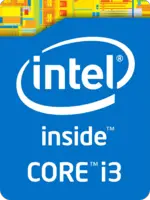| Intel Core i3 | |

| |
| Core i3 Logo | |
| Developer | Intel |
| Manufacturer | Intel |
| Type | Microprocessors |
| Introduction | June 17, 2009 (announced) September, 2009 (launch) |
| ISA | IA-32, x86-64 |
| µarch | Nehalem, Westmere, Sandy Bridge, Ivy Bridge, Haswell, Broadwell, Skylake |
| Word size | 64 bit 8 octets
16 nibbles |
| Process | 45 nm 0.045 μm , 32 nm4.5e-5 mm 0.032 μm , 22 nm3.2e-5 mm 0.022 μm , 142.2e-5 mm 14 nm
0.014 μm 1.4e-5 mm |
| Technology | CMOS |
| Package | FCBGA-1440, FCBGA-1364, FCBGA-1288, FCBGA-1168, FCLGA-1155, FCLGA-1151, FCBGA-1168, FCLGA-1150, FCBGA-1023, FCPGA-988, FCPGA-946 |
| Socket | LGA-1151, LGA-1150, LGA-1155, LGA-1156, Socket G1, Socket G2, Socket G3 |
| Succession | |
| ← | |
| Core 2 | |
Core i5 is family of mid-range performance processors introduced by Intel in 2009, following the retirement of the Core 2 family. Core i5 microprocessors are positioned between the high-end performance Core i7 and the low-end performance Core i3.
Contents
Overview
Intel first announced the retirement of the Core 2 in mid-2009 and was introduced later the same year. Core i5 are mid-range performance processors with performance higher than those offered by the Core i3 processors but below those offered by Core i7. Core i5 processors usually have more cores than i3 (typically 4 vs 2 in i3), and offer more features (e.g. Turbo Boost Technology)
Members
Intel has traditionally been grouping Core i5 processors into generations based on the microarchitecture they are based on with 1st generation being based on Nehalem in 45 nm with the latest chips based on Skylake manufactured using a 14 nm process.
1st Generation (Nehalem/Westmere)
- Main articles: Nehalem Microarchitecture and Westmere Microarchitecture
| This section is empty; you can help add the missing info by editing this page. |
2nd Generation (Sandy Bridge)
- Main article: Sandy Bridge Microarchitecture
| This section is empty; you can help add the missing info by editing this page. |
3rd Generation (Ivy Bridge)
- Main article: Ivy Bridge Microarchitecture
| This section is empty; you can help add the missing info by editing this page. |
4th Generation (Haswell)
- Main article: Haswell Microarchitecture
| This section is empty; you can help add the missing info by editing this page. |
5th Generation (Broadwell)
- Main article: Broadwell Microarchitecture
| This section is empty; you can help add the missing info by editing this page. |
6th Generation (Skylake)
- Main article: Skylake Microarchitecture
| This section is empty; you can help add the missing info by editing this page. |
| designer | Intel + |
| first announced | June 17, 2009 + |
| first launched | September 2009 + |
| full page name | intel/core i5 + |
| instance of | microprocessor family + |
| instruction set architecture | IA-32 + and x86-64 + |
| main designer | Intel + |
| manufacturer | Intel + |
| microarchitecture | Nehalem +, Westmere +, Sandy Bridge +, Ivy Bridge +, Haswell +, Broadwell + and Skylake + |
| name | Intel Core i3 + |
| package | FCBGA-1440 +, FCBGA-1364 +, FCBGA-1288 +, FCBGA-1168 +, FCLGA-1155 +, FCLGA-1151 +, FCLGA-1150 +, FCBGA-1023 +, FCPGA-988 + and FCPGA-946 + |
| process | 45 nm (0.045 μm, 4.5e-5 mm) +, 32 nm (0.032 μm, 3.2e-5 mm) +, 22 nm (0.022 μm, 2.2e-5 mm) + and 14 nm (0.014 μm, 1.4e-5 mm) + |
| socket | LGA-1151 +, LGA-1150 +, LGA-1155 +, LGA-1156 +, Socket G1 +, Socket G2 + and Socket G3 + |
| technology | CMOS + |
| word size | 64 bit (8 octets, 16 nibbles) + |